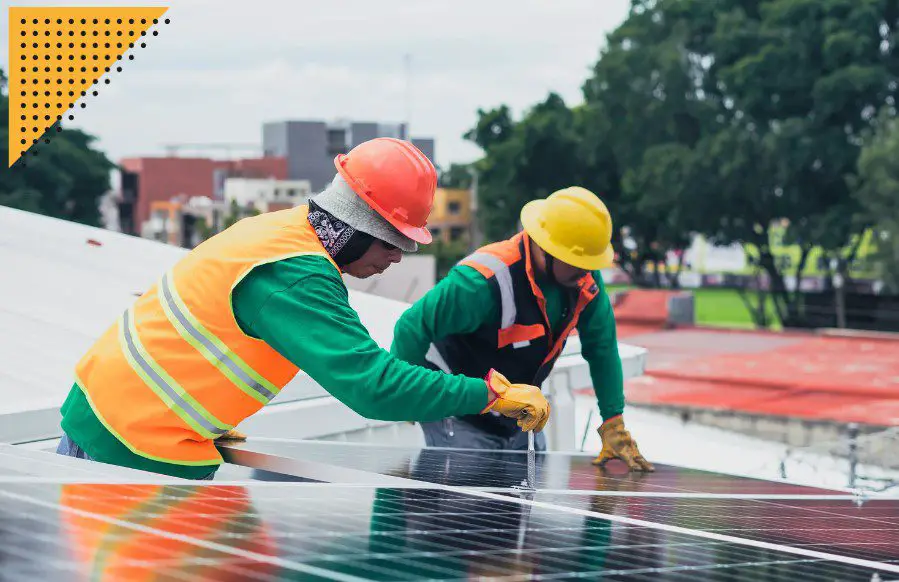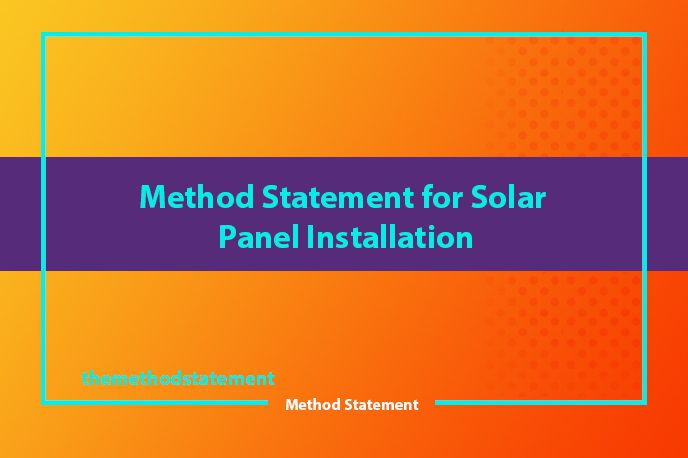Purpose
This Method Statement for Solar Panel addresses the hazards and controls involved with solar panel installation on a roof.
The purpose of this Solar Installation Safe Work Method Statement (SWMS) is to describe the sequential approach for the installation of PV Modules in accordance with the contract requirements.
This method statement shall ensure that the installation is executed safely. This aims to ensure that quality assurance and quality control activities are adopted by the contractor in a systematic manner.
The High-Risk Construction Work (HRCW) covered by this SWMS includes:
- Asbestos disturbance
- Chemical, fuel, or refrigerant lines; pressurized gas distribution mains or pipelines; powered electrical systems or services
- Includes work on telecommunications towers, which has a risk of a person falling from 2 meters or more.
- Work in a potentially polluted or flammable environment
For electrical equipment, slips, trips, falls, hazardous materials, hazardous manual tasks, outdoor work, and environmental considerations, additional controls are also provided.
Table of Contents
References
This method statement is subject to the requirements as stated in the following regulatory & statutory documents, applicable standards/specifications/building codes:
Project Specification
Project-approved materials/shop/IFC drawings
Supplier Installation Manual/Instructions.
Approved PV Module datasheet
PV Modules Installation Checklist
Module’s layout issued for construction IFC Drawings
Approved Project HSE Plan
Approved Project Emergency Response Plan
Approved Project Waste Management Plan
Occupational Health and Safety
Definitions
MS – Method Statement
ITP – Inspection and Test Plan
IFC – Issued For Construction
HSE – Health, Safety & Environment
QA/QC – Quality Assurance/Quality Control
PV – Photovoltaic
VOC – Open-circuit voltage
QCP – Quality Control Procedures
LSC – Luminescent Solar Concentrators
Access/Egress
Works will be started or carried out only when all associated main contractor’s procedures are completed and by ensuring safe access to work areas will be available through hoist lifts/access ladders to carry out the work where ever main contractor site engineer’s & safety officers clearance available.
Logistics
MEP Sub-contractor will deploy a dedicated team for the required logistics and material movement in –out of the project.
Health & Safety Hazards
Extreme heat and humidity
Extreme cold, high winds, and dusty condition
Mobile Equipment- Crane, forklift, etc. for material loading/offloading, transfer of materials to work locations
Temporary electrical supply for lighting, use of power tools, etc.
Manual handling / offloading & installation of PV modules
Damaged hand tools
Unsafe working on ladders
Poor housekeeping & waste management
Dissemination of HSE Information
HSE Site Safety Inductions
Work supervisors shall ensure STARRT and RAMS are discussed with the work group prior to works
commencing
Safety toolbox talks
Environmental toolbox talks
Training courses (Internal and Third Party Training)
HSE Bulletin/ HSE Site Notice Boards
Site Engineers, Site Supervisors, and Site Foreman
Permits and Certificates
Hot work permit (Cutting /Grinding)
Lifting Plan
Working at heights / Working on scaffolding – Supervisor to be trained by a third party.
MEWP – Third-party certification for the operator and the equipment. Competence certification for workers.
Responsibilities
Project Manager
The project manager shall be responsible for overall project planning, procurement, technical submissions, and drawing submissions,
The project manager shall coordinate activities within the site team and with the management for the timely completion of activity in accordance with contract requirements.
Construction Manager
The construction manager is responsible for the work execution in compliance with the approved method statement, HSE Risk Assessment, and project specification, issued for construction drawings, sections, and details.
Site Engineer
The site engineer is responsible to carry out the work as per approved shop drawings and method statements. He is also responsible to ensure adequate tool kits required for the works are in place prior to the starting of work. The site engineer reports to the Construction Manager.
The site Engineer is responsible to ensure work has been done as per the specification and drawings; inspections are carried out based on ITP and quality control procedures and coordinated with QA/QC department.
The site engineer is responsible to ensure that all safety precautions are ensured in place and that all personnel on site are using the required personal protective equipment like helmets, gloves, shoes, and reflective jackets. The site engineer in coordination with safety officers will ensure all relevant permissions are taken prior to the commencement of works.
The site engineers shall ensure that the works are supervised by a competent supervisor till the completion of the task.
QA/QC Department
The QA /QC department will be responsible for overseeing the quality requirements and quality control measures for the project in coordination with the project engineer and construction manager.
Safety Engineer
The HSE officer will be responsible for the safety, health, and environmental aspects on site as per the project safety and environmental requirements/safety standards in coordination with the project engineer and construction manager.
Methodology
Site Planning & Preparation
Before installation takes place, the following pre-installation task is essential:
Identify and ensure that pertinent documents (e.g. shop/coordination drawings, Method Statement for Solar Panel) are latest and approved.

Applicable permits shall be applied prior to the commencement of works.
Ensure obtain the necessary PTW (Permit to Work), prior to allowing to work.
Frequently training should be conducted by the site supervisor/foreman.
Daily safety briefings should be conducted.
Conduct site safety briefing prior to commencement of work.
Identify and obtain appropriate installation tools and equipment.
Determine the staffing required and assign tasks to team members.
Secure the working area and set up signs (where applicable) to alert anyone of danger in the area.
Notify appropriate personnel that work is to begin.
During the nighttime, working areas should be marked prominently with lights and there should be an arrangement to ensure the uninterrupted operation of these lights throughout the darkness.
Handling of Materials
During all the transportation, please make sure there is no strenuous vibration on the module. Because it may cause cell micro cracks or damage the module.
Upon receiving the materials, all must be inspected and ensured that there are no manufacturing defects or delivery damages.
The materials shall be handled with care and shall be stored in designated areas.
The manufacturer’s operational control procedure manual for handling installations should be followed as much as possible.
Nominated competent manpower shall be required a mandatory competent training such as electrician, etc. with approved 3rd party certifications shall be submitted and secure approval.
PV modules are made of glass and are there for at risk of fracture or cracking. Care of handling is to be a priority. Any suspected faulty modules should be set aside for return
To include strict implementation of housekeeping shall be improved during the course of the activity. Any materials stacked on the site shall neither obstruct the emergency evacuation route nor access this.
Rise the material inspection base on the material delivery.
Procedure
Put on the necessary PPE and slowly unpack the solar panels and hardware
The framework, solar panels, and fixings will all be mechanically raised to the installation location.
Measure and draw out the position of the framework. Always adhere to the manufacturer’s installation instructions and any site-specific drawings.
Survey the area for the exact position of the solar panel location.
Prepared railing and framework for construction.
Lift the “Y” framework, then place it on the ground.
Set the poles in place with concrete.
When the concrete has dried/firmed up, build the roofing or canopy structure on top of the “Y” frame.
Fix the framework railing to the canopy or roof.
To the electrical connection point, dig a cable trench.
Set up meters, inverters, and isolators.
Put solar panels on the railing.
All DC cables should be marked “DANGER Live DC.”
DC cables should be run from the panels’ backs to the cable trench.
According to the plans, install wires and conduits inside the trench.
Before connecting to the supply, use an electrical test meter to make sure it is dead.
All electrical parts and warning signals should be labeled.
Affix AC cables to the equipment’s terminal boxes for the isolator, meter, and inverter.
Complete all cable connections, both DC and AC.
Verify the security and integrity of all cables and connections.
All non-live testing will be done before the system is restarted.
Check the operation of the new circuit after energizing the power supply.
Clean up the work area and place all trash in the designated garbage container.
Always leave the site in a secure state.
Commission the system.
Complete any snagging work. to client satisfaction.
Carry out the final inspection.
Testing process
- Make sure that all string is connected perfectly
- Disconnect the string from the inverter side
- Do the Voc test by AVO Meter to ensure that all string’s voltage is in the accepted range
- Connect the I-V device at the end of the strings
- Check the Voc, Isc, and the insulation of cables
- Compare the ideal with the actual measurement
- Check the string polarity
- Disconnect the device cables after finishing the test
This test should accord the following:
- VOC
- LSC
- String I-V curve with reference to the irradiation and the panel inclination
- IR of cables
- Continuity of string
- Polarity of string
Training
All required training for stipulated installation activities is provided to all technical staff for ensuring quality workmanship.
Working Hours
Site operational time shall be followed as per project progress requirements, and all relevant local authority schedules of holidays are to be observed.
Working Hours (Working in direct sunlight during hot weather conditions).
Housekeeping
Working areas will be kept clean by disposing of the waste materials in the designated areas. At the end of the day’s work, the installation supervisor will ensure that the debris is disposed of during the course of the activity on regular basis.
Dust created by work e.g. drilling, of the slab, grinding, and polishing: The area must be isolated and protected by a green net and require additional PPE for the operatives.
Any materials stacked on the site shall neither obstruct the emergency evacuation route.
See also: Method Statement for Civil Engineering
Manpower
Subject to main contractors’ programmer and scope/area available for MEP activities, but not limited to below:
Foreman
Charge hands
Electricians
Assistant Electricians
Welder (for fabrication as needed)
Helpers
H&S Officer
Scaffolders
Materials
PV modules and accessories
Control cable, small power wires, etc.
Machine Bolt, nuts, and washers
Rawl plugs and screws
Anchor bolts/hammer set anchor
Personal Protective Equipment
Safety Helmet
Safety Goggles
Safety Boots
High Visibility Vest
Hand Gloves
Ear Plugs
Respiratory Protection
Full body harness
Plant & Equipment
The following equipment and materials shall be used for the works:
Wrench torque
MC4 crimping tools
Set of screwdriver
Water level/spirit level
Measuring tape
Ladder (Appropriate types)
Appropriate Safety equipment
Fire Extinguisher
Notes:
Third-party certification (competence certificates) for workers, operators, Equipment valid registration, insurance, and fitness certificates, and operator daily inspection checklist should be available for Safety officer validation before commencing the works.
QC Approval Documents
Follow the approved Method Statement for solar panel installation, ITP, QCP, HSE Plan, and Material Approval & Checklist.
Supporting Documentation
This Method statement for Solar Panel installation is to be read in conjunction with the below-referenced documents:
Contract Specification & approved drawings
Project Quality Plan
Project HSE Plan
tag: method statement for solar panel, Solar Installation Safe Work Method Statement (SWMS)
